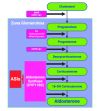New Therapies for the Management of Chronic Kidney Disease
- PMID: 40337581
- PMCID: PMC12057290
- DOI: 10.7759/cureus.81824
New Therapies for the Management of Chronic Kidney Disease
Abstract
A major public health concern gripping the nation is chronic kidney disease (CKD), and for individuals concomitantly diagnosed with type 2 diabetes mellitus (T2DM), the coexistence significantly increases the cardiovascular morbidity and mortality by two to three times higher than patients diagnosed without CKD. CKD management encompasses both non-pharmacological approaches, such as dietary sodium restriction and lifestyle modification for blood pressure control, and pharmacological approaches. Current pharmacological management focuses on four key pillars: renin-angiotensin system inhibitors (RASi), sodium-glucose cotransporter-2 inhibitors (SGLT2i), glucagon-like peptide-1 receptor agonists (GLP-1RA), and mineralocorticoid receptor antagonists (MRAs), all of which have shown renoprotective and cardiovascular benefits. An incomplete block of aldosterone activity remains a challenge and is one of the factors contributing to the progression of kidney damage. Aldosterone synthase inhibitors (ASIs), such as vicadrostat, may represent a new horizon in selectively inhibiting aldosterone synthesis while preserving cortisol production. Early-phase trials have shown reductions in albuminuria and a potential for renal protection. The question is, could ASIs emerge as a fifth pillar in CKD management and help curb the progression?
Keywords: ace inhibitors; aldosterone; chronic kidney disease; mineralocorticoid receptor antagonists; sglt2 inhibitors.
Copyright © 2025, Treihaft et al.
Conflict of interest statement
Conflicts of interest: In compliance with the ICMJE uniform disclosure form, all authors declare the following: Payment/services info: All authors have declared that no financial support was received from any organization for the submitted work. Financial relationships: All authors have declared that they have no financial relationships at present or within the previous three years with any organizations that might have an interest in the submitted work. Other relationships: All authors have declared that there are no other relationships or activities that could appear to have influenced the submitted work.
Figures



References
Publication types
LinkOut - more resources
Full Text Sources
Miscellaneous
